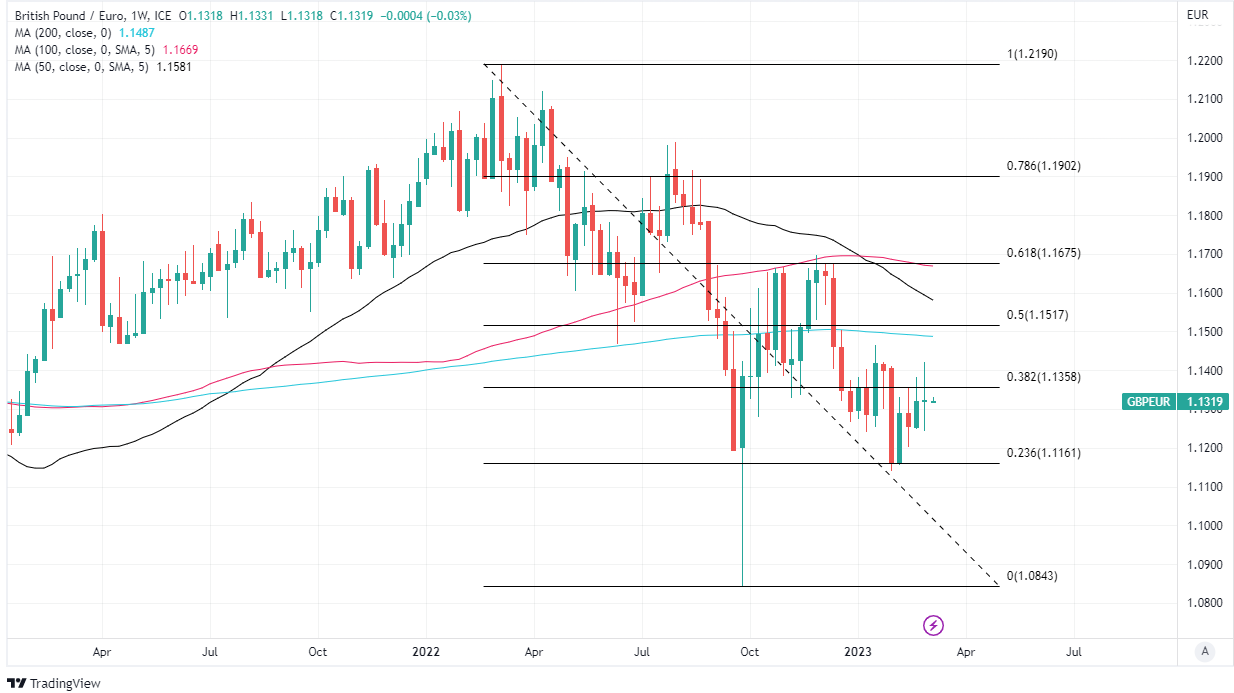GBP/EUR Week Ahead Forecast: Chance of Another Run at 1.14
- Written by: James Skinner
-
- GBP/EUR supported near 1.1315 & 1.1273 further down
- Risk or chance of another approach towards 1.14 ahead
- EUR & global factors in focus ahead of UK January GDP

Image © Adobe Images
The Pound to Euro exchange rate came close to 2023 highs before eventually being toppled last week but it could be likely to make a further attempt at returning to the 1.14 handle in the days ahead if the single currency is obliging and global market conditions are conducive.
Sterling rallied strongly and widely in the opening leg of last week after S&P Global PMI surveys suggested that January may have seen the UK draw a line under the weakness seen in the final quarter last year owing partly to declines in wholesale energy prices that are a form of balm for the economic outlook.
The Pound would potentially benefit this week if the Chinese government announces any stimulus to support its pursuit of the more modest than usual GDP growth target revealed at the opening of the annual Two Sessions meeting of lawmakers over the weekend.
But continental economic figures and a still-hawkish European Central Bank (ECB) interest rate stance are both potential headwinds for GBP/EUR.
"The ECB doesn’t have a ceiling, but an inflation target of 2%. That is the medium-term inflation target, which is how price stability is defined for us. As I said, I cannot tell you how high rates will go. I know that they will be higher than they are now and we still have more work to do because we cannot declare victory. We are making progress, but we still have work to do," President Christine Lagarde told Spain's El Correo in an interview this weekend.
Above: Pound to Euro rate shown at daily intervals with Fibonacci retracements of September 2022 recovery denoting possible areas of technical support for Sterling while selected moving averages indicate prospective support and resistance. Click image for closer inspection.
Last week's losses came after Bank of England (BoE) Governor Andrew Bailey and Chief Economist Huw Pill said they have viewed recent UK economic data as broadly in line with February's forecast for a softening of labour market conditions and sharp decline of inflation later this year.
"Inflation has been slightly weaker, and activity and wages slightly stronger, though I would emphasise ‘slightly’ in both cases. A further set of data will be coming in before our next monetary policy decision later this month," Governor Bailey told a Brunswick Group conference last Wednesday.
"At this stage, I would caution against suggesting either that we are done with increasing Bank Rate, or that we will inevitably need to do more," he added.
Trivia;
The Sveriges Riksbank of Sweden is widely accepted as being the oldest central bank of them all and the Bank of England has not begged to differ but Poland's Narodowy Bank Polski might be likely to take another view.
"The oldest issuing (central) bank is deemed to be the Bank of England (1694), which has existed continuously to the present day. The only older European bank was the issuing bank of Sweden (1668), which went bankrupt after a short period of activity," the footnote on page 4 in An Outline History of Polish Central Banking says.
Governor Bailey and Huw Pill's non-committal stance on the outlook for borrowing costs appeared to stifle an earlier increase in market-implied expectations for Bank Rate last week and may have played a role in dampening appetite for the Pound.
Bank Rate will be top of mind for the market again this Friday when the Office for National Statistics releases its initial estimate of GDP for January.
"All told, further rate hikes can’t be ruled out, but markets’ decision to price in a near-zero chance of the MPC keeping Bank Rate at 4.0% this month looks foolhardy in light of Bailey's comments," says Samuel Tombs, chief UK economist at Pantheon Macroeconomics.
"We see the odds as being relatively evenly balanced between the Committee keeping Bank Rate at 4.0% and nudging it up to 4.25% in the first half of this year," Tombs writes in a Monday research briefing.
The consensus among economists is that December's steep -0.5% fall in GDP will be followed by a meager +0.1% rebound in January but Tombs and colleagues are more optimistic than their industry counterparts in forecasting a 0.4% increase this week.
That would potentially stand the economy in good stead for the remainder of the first quarter and could potentially help the Pound to Euro rate to draw a line under its recent declines over the coming week, though much also depends on how the market view of the ECB policy outlook evolves in the days ahead.
"Nonetheless, GDP likely will be weighed down in Q2 by falls in business and residential investment, which are sensitive to changes in the cost of borrowing. As a result, we look for a 0.3% quarter-on-quarter decline in Q2," Tombs says.
"All told, then, we still think that GDP will be lower in 2023 than in 2022, albeit now by a fairly modest 0.3%," he adds.









